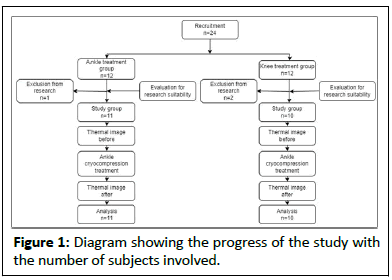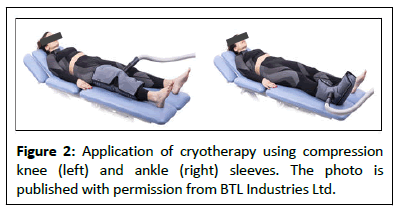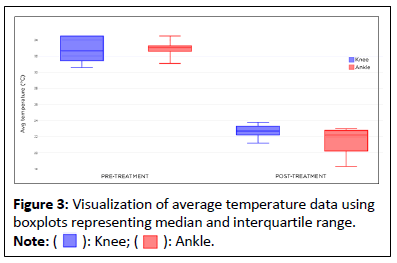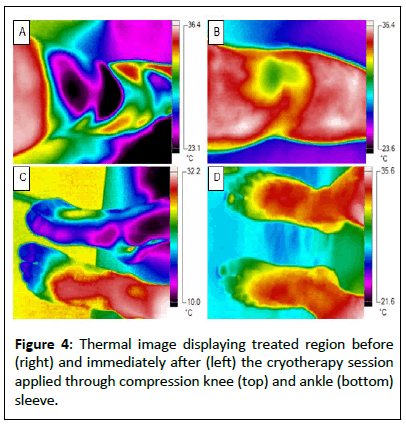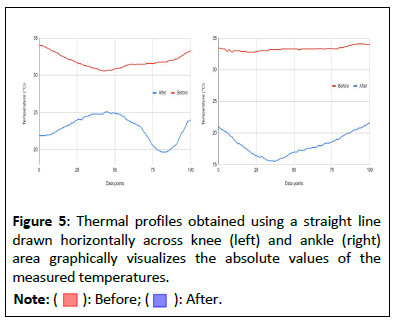Temperature Reduction after Cryotherapy through Knee and Ankle Compression Sleeves
Jiri Kminek
Health Committee of the Dukla Prague Sports Club, Prague, Czech Republic
Published Date: 2023-12-21DOI10.36648/2471-8416.9.5.403
Jiri Kminek*
Health Committee of the Dukla Prague Sports Club, Prague, Czech Republic
- *Corresponding Author:
- Jiri Kminek
Health Committee of the Dukla Prague Sports Club, Prague,
Czech Republic,
E-mail: jikminek@gmail.com
Received date: November 20, 2023, Manuscript No. IPJCEOP-23-18141; Editor assigned date: November 23, 2023, PreQC No. IPJCEOP-23-18141 (PQ); Reviewed date: December 07, 2023, QC No. IPJCEOP-23-18141; Revised date: December 14, 2023, Manuscript No. IPJCEOP-23-18141 (R); Published date: December 21, 2023, DOI: 10.36648/2471-8416.9.5.403
Citation: Kminek J (2023) Temperature Reduction after Cryotherapy through Knee and Ankle Compression Sleeves. J Clin Exp Orthopr Vol.9 No.5: 403.
Abstract
Background: Cold therapy has been known and widely used since ancient Egypt for its beneficial therapeutic and stimulating effects used in tissue healing and post exercise recovery. The recently introduced combination of cryotherapy and compression could intensify the effects of cold through their interaction.
Methods: Twenty-one volunteers underwent a single application of cryotherapy via knee or ankle compression sleeves. Thermal images were taken before and immediately after 12 minutes of combined cold and compression therapy to evaluate temperature reduction and compare it with the results of existing clinical evidence.
Results: A statistically significant decrease in temperature was evaluated across all temperature indicators (average, minimum and maximum) for both treated areas. The magnitude of the average temperature reduction reached a value of 10.11°C ± 1.68°C and 11.87°C ± 1.55°C for the knee and ankle, respectively. In the case of the minimum values evaluated by the area analysis of the cooled areas, a significant difference in favor of the ankle was reported.
Conclusion: Cold air cryotherapy combined with compression has proved to be effective in temperature reduction across the treated area by more than 10°C. From the point of view of physiotherapists, this is the promise of an effective and manually undemanding application of cryotherapy in the knee and ankle area.
Keywords
Cryocompression; Hands-free cryotherapy; Cooling effect; Lower limb rehabilitation
Introduction
The analgesic and anti-inflammatory effect of cold was already known and used by the ancient Egyptians [1]. Hippocrates from ancient Greece is often referred to as the grandfather of cryotherapy due to his mention of the effect of snow and ice on reducing swelling [2]. Reducing and slowing down hematoma formation is one of the many benefits of cold therapy. Cryotherapy causes a reduction in blood flow, capillary constriction and tissue metabolism, which contributes to limiting the extent of injury by reducing the inflammation response and secondary cell death. Other physiological effects are also attributed to cold, including analgesic, myorelaxant, hyperemic, immune, acceleration of tissue regeneration after sports performance and others [3-5].
Although the original concept of hydrotherapy is still preserved and widely used in the form of cold-water immersion, new methods enabling a quick and effective reduction of temperature locally or of the entire body have been developed over the past 200 years [1,2]. In general, cryotherapy procedures can be divided into three groups: Whole-body cryotherapy, performed using a cryochamber; partial-body cryotherapy, performed without exposure of the head; and local cryotherapy, exposing only certain body areas to cold. Local cryotherapy, in addition to classic methods such as ice bag, frozen peas, ice towels, ice massage, gel packs, hypothermic blanket, etc., also includes specialized devices working on the principle of cooling gasses (cold air, carbon dioxide microcrystals and liquid nitrogen vapors) [3]. The latest addition to local cryotherapy is the application of cold through compression sleeves, enabling therapy without the therapist's manual involvement. The aforementioned effects of cold are supported during therapy by the compression affecting oxygen rich blood flow, preventing muscles from micro-trauma by enhanced stability, reducing swelling and inflammation and improving proprioception [6].
Despite the fact that cryotherapy devices differ in their principle of operation, cooling temperature (from 0°C-195°C), number of exposures (from 1 to 20) and duration of each application (from 2 min-30 min), clinical evidence comparing their cooling efficiency is insufficient [3,7]. While Costello et al. compared knee skin temperature decreases during a 4 minute exposure to -110°C whole body cryotherapy and 8°C water cold immersion, Radecka et al. focused on local cryotherapy and compared the effect of individual cooling agents (liquid nitrogen vapors, cold air and ice bag) on the dynamics of temperature changes in the knee joint area [3,8]. In another study, Costello et al. extended the comparison of whole body cryotherapy and cold water immersion by the muscle and core temperature [9]. The temperature change after whole body cryotherapy exposure in a cryo cabin and cryogenic chamber was also monitored by Savic et al. and Cholewka et al. respectively [7,10]. The conclusions of the existing clinical evidence can be summarized by stating that the reduction of average temperatures immediately after the application of cryotherapy in the knee area is in the range of 10.11°C-12.1°C for whole body cryotherapy, 7.59°C-9°C for cold water immersion and 6.76°C for cold air local cryotherapy [3,7-10]. Given that the temperature difference achieved by cold air cryotherapy was evaluated only by a single study, in which a device without compression sleeves was used, it can be assumed that in the case of compression combined therapy the reduction will be more pronounced. As demonstrated by Tomchuk et al., compresses during cold therapy can contribute to a greater decrease in temperature by up to 1°C-2°C [11].
The aim of this study is to demonstrate, immediately after the application of cold air cryotherapy via ankle and knee compression sleeves, a significant temperature reduction greater than 9°C. The temperature differences between the ankle and the knee will be evaluated and mutually compared.
Materials and Methods
The measurement was conducted as part of an experimental research on healthy subjects during November 2023. For the purposes of evaluating the statistical significance of temperature reduction after the application of cryotherapy, a minimum sample size of 2 subjects was calculated based on the results of the previous research and the expected temperature difference. For the purposes of mutual comparison between the knee and the ankle, the sample size was estimated at a minimum number of 10. In both cases, this estimate was calculated in order to detect a significant (p<0.05) difference with 80% power [12].
Healthy adult individuals were recruited for the study. During the recruitment period, 24 volunteers were enrolled and their therapy suitability was subsequently evaluated. Exclusion criteria included all contraindications for cryotherapy as well as compression treatment: Raynaud’s disease or cold hypersensitivity (cold urticaria), open wounds, cardiovascular and blood perfusion disorders, skin sensitivity disorder, advanced diabetes mellitus, spinal cord injury, acrocyanosis, vascular inflammation, systemic lupus erythematosus, cold induced bronchospasm, any hematological disorder affecting blood clotting, decompensated hypertension, acute, unstable fracture in the treatment zone, clinical signs suggesting deep vein thrombosis in affected region, clinical signs or risk factors suggesting embolism and conditions where increased venous or lymphatic return is not desired in affected region. Due to the possible influence of the thermal profile of the treated area, subjects with an ongoing infection, menstruation in women and those who are currently taking any medication or experienced any lower limb injury in the last 2 years were also excluded. Ultimately, a group of 21 volunteers became part of the research. All participants were informed about the course, purpose and possible publication of the study and confirmed their interest by signing a written consent, in line with the Helsinki Declaration [13].
The course and sequence of research procedures with the number of involved participants are schematically visualized in Figure 1.
The participants were equally divided into two groups: the first group completed therapy and measurements in the knee area and the second in the ankle area.
Therapy and measurements took place in a room with controlled temperature (21°C ± 1°C) and environmental humidity (50%). Before the therapy itself, each participant was asked to rest uncovered on a couch for 20 minutes to stabilize their body temperature. The treated area was then photographed with a Fluke Ti32 thermal camera (Fluke Corporation, Everett, Washington) with an emissivity set at 0.98 and features meeting medical infrared imaging standards and guidelines (sensitivity ≤ 45 mK NETD, spectral range 8-14 μm, resolution 320-240 pixels, spatial resolution 2.5 mRad IFOV at a distance of 7.5 cm from the detector, accuracy ± 2°C or 2%) [14]. The thermal camera was switched on with the start of a 20 minute rest period and calibrated before the actual measurement.
Cryotherapy was delivered via a cold-air device (BTL Industries, Ltd.) through ankle and knee compression sleeves (Figure 2). This approach allows the application of cold and compression simultaneously without the need for significant manual operator involvement. Maximum airflow level was used in order to deliver the temperature specified by the manufacturer at the nozzle output -35°C. The therapy lasted 12 minutes, and immediately afterwards, the photographing of the treated area with a thermal camera was repeated.
Thermal images were displayed and processed for further analysis in the dedicated Fluke Smartview 4.3 program (Fluke Corporation, Everett, Washington). Graphs of thermal profiles were created based on a straight line drawn through the center of the treated area.
The minimum, maximum and average temperature values were determined using a surface analysis of the treated area. Evaluation of data obtained from thermal images and their statistical analysis was performed using a custom-written script (Matlab R2023a, MathWorks Inc., Natick, Massachusetts).
Since the Shapiro-Wilk test rejected the normal distribution of the data, the statistical significance of the difference between the temperatures measured before and after the application of cryotherapy was evaluated using the nonparametric Wilcoxon sign rank test.
The non-parametric Mann-Whitney U test was further used for a mutual comparison of the knee and ankle temperatures. The p value <0.05 was considered statistically significant.
Results
A total of 10 subjects underwent cryotherapy using compression knee sleeve and 11 subjects underwent the same therapy through ankle sleeve. The participants were distributed into the knee group as follows: 6 men and 4 women aged 34.1 ± 7.42, right and left knee treated in a ratio of 1:1. Ankle group consisted of 7 men and 4 women, aged 32.27 ± 10.46, with 6 times treated right and 5 times left ankle. No side effects were reported during the session, the treatment was well tolerated by all subjects without the need to interrupt or terminate the 12 minute protocol.
Pre and post treatment temperature data and temperature reductions are summarized in Table 1. A decreasing temperature trend is visible across all indicators for both treated areas. The magnitude of the average temperature reduction reached a value of 10.11°C ± 1.68°C for the knee, and 11.87°C ± 1.55°C for the ankle. The minimum values on the treated area recorded an even greater decrease of 11.16°C ± 2.02°C and 13.75°C ± 1.51°C at the knee and ankle, respectively.
| Pre (°C) | Post (°C) | Temperature reduction | ||||
|---|---|---|---|---|---|---|
| Knee | Ankle | Knee | Ankle | Knee | Ankle | |
| Average (SD) | 32.77 (1.50) | 33.02 (0.92) | 22.66 (0.80) | 21.36 (1.78) | 10.11 (1.68) | 11.67 (1.55) |
| Minimum (SD) | 31.73 (1.72) | 32.01 (1.17) | 20.57 (1.08) | 18.25 (2.13) | 11.16 (2.02) | 13.75 (1.51) |
| Maximum (SD) | 33.83 (1.23) | 33.97 (0.89) | 24.70 (1.11) | 24.13 (1.32) | 9.13 (1.52) | 9.85 (1.61) |
Table 1: Summary of temperature data obtained by analyzing the treated area on thermal images recorded before (pre) and immediately after (post) the cryotherapy. Data are represented as mean (standard deviation).
The difference in the average temperatures of the treated areas before and after cold therapy is shown in Figure 3. The temperature drop is comparable for both treated body parts.
Statistical evaluation using the Wilcoxon sign rank test confirmed a significant drop in temperatures both at the knee and ankle level (Table 2). Although the comparison of pretreatment values between the ankle and the knee did not reveal any difference, a mutual comparison of the post-treatment data and achieved reduction using the Mann-Whitney U test revealed a significant difference in favor of the ankle at the temperature minimum. There was no significant difference in average and maximum temperature values or in any temperature indicator recorded before therapy.
| Mann-Whitney U test | Wilcoxon sign rank test | ||||
|---|---|---|---|---|---|
| Pre | Post | Temperature reduction | Knee | Ankle | |
| Average | 0.646 | 0.091 | 0.078 | 0.002 | <0.001 |
| Minimum | 0.943 | 0.005 | 0.006 | 0.002 | <0.001 |
| Maximum | 0.75 | 0.341 | 0.36 | 0.002 | <0.001 |
Table 2: Results of statistical analysis of temperature data. The Wilcoxon sign rank test was used to compare the temperature values measured before the start of cryotherapy and immediately after its termination. Mutual comparison of the values measured for the knee and ankle was performed using the Mann-Whitney U test. The p values <0.05 were considered statistically significant.
Thermal images of the knee and ankle taken before and after combined cold and compression therapy are shown in Figure 4. Both the images confirm a significant drop in temperature across the entire treated area.
Figure 5 shows thermal profiles obtained by analyzing knee and ankle thermal images. A significant drop in temperature across both treatment areas is evident and the minimum absolute temperature value is close to 20°C and 15°C for knee and ankle, respectively.
Discussion
Clinical evidence regarding the physiological and cooling effect of specialized cryotherapy units is still insufficient despite the relatively long history of their use. Although there are several studies describing the effectiveness of various cryotherapy methods on post-surgical and post-exercise recovery and improving athletic performance, most of them focus on the effect of cold water immersion and whole body cryotherapy [15-18].
In the case of local cryotherapy technology and its combination with compression, the evidence is almost non-existent. According to previous research, the temperature reduction on the skin occurring during cryotherapy with various cooling media ranges from 6.76°C (cold air) to 12.1°C (whole body cryotherapy) [3,7-10]. Research by Tomchuk et al. indicated that compression during cold therapy contributes to the strengthening of the cooling effect and therefore it can be assumed that the effect of combined cold air cryotherapy will achieve better results [11].
Based on this assumption, a null hypothesis was established that combined cold and compression therapy would achieve a temperature difference exceeding 9°C. Since a decrease exceeding 10°C was reported for both the knee and ankle regions, the null hypothesis can be confirmed. Such temperature reduction corresponds to the results achieved using highperformance cooling media producing temperatures below -100° C [3,8,9].
The finding that a similar cooling effect can be achieved using cold air cryotherapy applied through compression sleeves is very promising for use in current physiotherapy. Compared to other cooling methods, this is a relatively compact and portable technology that enables fast and manually completely undemanding local therapy.
As mentioned above, the achieved magnitude of temperature reduction exceeding 10°C is entirely consistent with existing research. In the case of the ankle, the decrease was even more pronounced reaching a reduction of 11.67°C. The difference in minimum temperatures within the treated area between the ankle and the knee reached statistical significance.
The lower temperature of the ankle compared to the knee can probably be attributed to the properties associated with acral and non-acral skin. While the knee can clearly be attributed to the thermoregulatory properties of non-acral skin, the ankle is directly connected to the foot, which in terms of thermoregulation and blood flow can be described as acral. Acral areas, which in addition to feet also include nose, ears and hands, have specific Arteriovenous Anastomoses (AVA) in the cutaneous vasculature, which enable rapid shifts of blood to or from the skin surface and thus, in the case of thermal challenges, function as thermoregulatory organs [19]. Elstad et al. confirmed this theory in practice when they gradually exposed acral and non-acral areas of the body to different ambient temperatures and monitored the change in their skin temperature and blood flow. It turned out that the acral areas react more significantly to the change in ambient temperature in the case of its decrease; there is a higher skin temperature drop and a higher increase in blood flow [20].
The main limitation of the study is the absence of a control group or a control limb that would undergo the same intervention with another commercially available cryotherapy technology or the same technology, but without the use of compression sleeves. Another source of inaccuracy can be the inclusion of only one treatment session, in the case of multiple therapies and measurements, the risk of possible influence of temperatures would be reduced. In the future, it is proposed to expand the research to include in-depth measurements directly in the tissue, for example in the muscle, and to monitor the development of the temperature at regular intervals after the end of the therapy for a longer period of time, for example 60 mins.
Despite all the mentioned limitations, the present study is the first to evaluate the cooling effect of combined cryotherapy with compression applied through ankle and knee sleeves.
Conclusion
Cold air cryotherapy combined with compression has proved to be effective in temperature reduction across the treated area. Cold air cryotherapy applied through compression sleeves was able to effectively reduce the temperature across the treated area by more than 10°C. From the point of view of physiotherapists, this is the promise of an effective, affordable and manually undemanding application of cryotherapy in the knee and ankle area.
References
- Cooper SM, Dawber RP (2001) The history of cryosurgery. J R Soc Med 94: 196-201.
[Crossref], [Google Scholar], [Indexed]
- Allan R, Malone J, Alexander J, Vorajee S, Ihsan M, et al. (2022) Cold for centuries: A brief history of cryotherapies to improve health, injury and post-exercise recovery. Eur J Appl Physiol 122: 1153-1162.
[Crossref], [Google Scholar], [Indexed]
- Radecka A, Pluta W, Lubkowska A (2021) Assessment of the dynamics of temperature changes in the knee joint area in response to selected cooling agents in thermographic tests. Int J Environ Res Public Health 18: 5326.
[Crossref], [Google Scholar], [Indexed]
- Bleakley CM, Hopkins JT (2010) Is it possible to achieve optimal levels of tissue cooling in cryotherapy? Phys Ther Rev 15: 344-350.
[Crossref], [Google Scholar]
- Swenson C, Swärd L, Karlsson J (1996) Cryotherapy in sports medicine. Scand J Med Sci Sport 6: 193-200.
[Crossref], [Google Scholar], [Indexed]
- DuPont WH, Meuris BJ, Hardesty VH, Barnhart EC, Tompkins LH, et al. (2017) The effects combining cryocompression therapy following an acute bout of resistance exercise on performance and recovery. J Sports Sci Med 16: 333-342.
[Google Scholar], [Indexed]
- Miroslav S, Borut F, Nejc S (2013) Actual temperature during and thermal response after whole-body cryotherapy in cryo-cabin. J Therm Biol 38: 186-191.
[Crossref], [Google Scholar]
- Costello JT, Culligan K, Selfe J, Donnelly AE (2012) Muscle, skin and core temperature after -110°C cold air and 8°C water treatment. PloS one 7: e48190.
[Crossref], [Google Scholar], [Indexed]
- Costello JT, Donnelly AE, Karki A, Selfe J (2014) Effects of whole body cryotherapy and cold water immersion on knee skin temperature. Int J Sports Med 35: 35-40.
[Crossref], [Google Scholar], [Indexed]
- Cholewka A, Stanek A, Wójcik M, Stolny KS, Drzaga Z (2017) Does local cryotherapy improve thermal diagnosis similar to whole-body cryotherapy in spinal diseases? J Therm Anal Calorim 127: 1155-1162.
[Crossref], [Google Scholar]
- Tomchuk D, Rubley MD, Holcomb WR, Guadagnoli M, Tarno JM (2010) The magnitude of tissue cooling during cryotherapy with varied types of compression. J Athl Train 45: 230-237.
[Crossref], [Google Scholar], [Indexed]
- Charan J, Biswas T (2013) How to calculate sample size for different study designs in medical research? Indian J Psychol Med 35: 121-126.
[Crossref], [Google Scholar], [Indexed]
- Council of Europe (1997) Convention for protection of human rights and dignity of the human being with regard to the application of biology and biomedicine: Convention on human rights and biomedicine. Kennedy Inst Ethics J 7: 277-290.
[Crossref], [Google Scholar], [Indexed]
- William A (2018) International academy of clinical thermology medical infrared imaging standards and guidelines.
- Engelhard D, Hofer P, Annaheim S (2019) Evaluation of the effect of cooling strategies on recovery after surgical intervention. BMJ Open Sport Exerc Med 5: e000527.
[Crossref], [Google Scholar], [Indexed]
- Moore E, Fuller JT, Buckley JD, Saunders S, Halson SL, et al. (2022) Impact of cold-water immersion compared with passive recovery following a single bout of strenuous exercise on athletic performance in physically active participants: A systematic review with meta-analysis and meta-regression. Sports Med 52: 1667-1688.
[Crossref], [Google Scholar], [Indexed]
- Alex J, Tianyi L, Christopher M, Michael F (2019) Cryotherapy duration is critical in short-term recovery of athletes: A systematic review. Journal of JISAKOS 4.
[Crossref], [Google Scholar]
- Azevedo KP, Bastos JAI, Neto IVS, Pastre CM, Durigan JLQ (2022) Different cryotherapy modalities demonstrate similar effects on muscle performance, soreness, and damage in healthy individuals and athletes: A systematic review with meta-analysis. J Clin Med 11: 4441.
[Crossref], [Google Scholar], [Indexed]
- White MD, Bosio CM, Duplantis BN, Nano FE (2011) Human body temperature and new approaches to constructing temperature-sensitive bacterial vaccines. Cell Mol Life Sci 68: 3019-3031.
[Crossref], [Google Scholar], [Indexed]
- Elstad M, Vanggaard L, Lossius AH, Walløe L, Bergersen TK (2014) Responses in acral and non-acral skin vasomotion and temperature during lowering of ambient temperature. J Therm Biol 45: 168-174.
[Crossref], [Google Scholar], [Indexed]
Open Access Journals
- Aquaculture & Veterinary Science
- Chemistry & Chemical Sciences
- Clinical Sciences
- Engineering
- General Science
- Genetics & Molecular Biology
- Health Care & Nursing
- Immunology & Microbiology
- Materials Science
- Mathematics & Physics
- Medical Sciences
- Neurology & Psychiatry
- Oncology & Cancer Science
- Pharmaceutical Sciences
